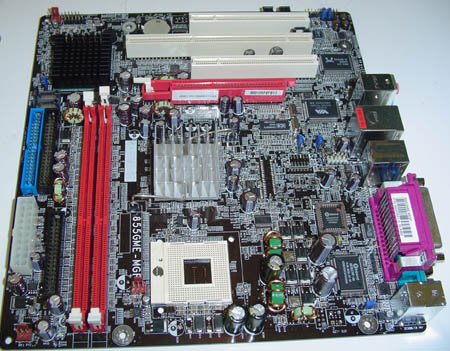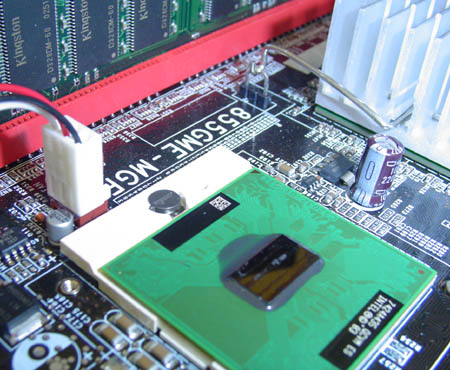Linux and the Desktop Pentium M: Uncommon Performance
by Kristopher Kubicki on December 24, 2004 12:00 PM EST- Posted in
- Linux
Motherboard Details
As we had briefly mentioned earlier, all desktop Dothan/Banias motherboards are all derived from blade configurations. The key term used when describing a blade is density; things tend to be a little smaller, and cost generally takes a back seat to thermal reduction and size reduction. Like a Beowulf cluster, there isn't a lot of need for top of the line, best of breed components so long as the components used are reliable, cool and small. After all, what is a 10% dip in performance on one blade if you can double the number of blades that sit in the same rack?All Pentium M blades run on Intel's notebook 855GME chipset. This chipset really doesn't differ from any other Dothan notebook chipset; DDR1, AGP/PCI, ICH5 and 400MHz front side bus. The 6300ESB southbridge provides a 64-bit PCI-X (not to be confused with PCI-Express) bus, which is generally dedicated to fiber optic networking.
For these sets of benchmarks, we selected the DFI 855GME-MFG motherboard but AOpen also sells a retail i855GME motherboard. Even though both motherboards come in MicroATX form factors and use relatively older bridges, these boards are very expensive - mostly due to the fact that they have no competition! At time of publication, our DFI 855GME-MFG cost a little over $250, which is a considerable amount to pay for a motherboard. On the other hand, if we buy a comparative top of the line Socket 775 motherboard, with all the trimmings, $250 isn't too much to spend.
DFI and AOpen do not differ much in design of their desktop Dothan motherboards, but DFI's board has a few extra amenities. A Realtek gigabit Ethernet port, six-channel VIA audio and Winbond Firewire are also standard on this motherboard - although, we had difficulties getting SUSE 9.1 and the Realtek 8110S Ethernet to play well together due to driver conflicts. For the duration of the analysis, we used an Intel Pro/1000+ Ethernet controller, but that should not affect our benchmarks. Our motherboard only supports a 4X AGP bus, but as we have seen in dozens of benchmarks before, that should hardly affect video performance, if at all.












47 Comments
View All Comments
- Saturday, October 24, 2009 - link
http://www.goph3r.com/mh">http://www.goph3r.com/mh(air jordan, air max, shox tn, rift, puma, dunk sb, adidas) nike jordan shoes 1-24 $32
lv, coach, chane bag $35
COOGI(jeans, tshirts, hoody, jacket) $30
christian audigier(jeans, tshirts, hoody) $13
edhardy(shoes, tshirts, jeans, caps, watche, handbag) $25
Armani(jeans, tshirts,) $24
AF(jeans, coat, hoody, sweater, tshirts)Abercrombie & Fitch $31
http://www.goph3r.com/mh">http://www.goph3r.com/mh
BullCreek - Thursday, January 13, 2005 - link
Does anyone know where I can buy socket479 dothan core pentium Ms online? Newegg and various other places stock the socket 478 variety, but I haven't found anyone that has the socket 479 type.vl - Thursday, December 30, 2004 - link
If you are using an IDE drive make sure DMA was enabled. To check you can use the hdparm command.Lynx516 - Tuesday, December 28, 2004 - link
Something is disasterously wrong with your setup. Have you tried using a live CD and try compiling with that?What command are you using to compile the kernel? Are you sure you have GCC installed correctly? What do you get if you type gcc-config -l?
Are you sure nothing else is running (well major tasks)?
Have you tried running it as root?
KristopherKubicki - Tuesday, December 28, 2004 - link
Correct they are "user". Here are the results with GCC 3.4.3 on the same system on the second run.real 20m42.192s
user 16m39.148s
sys 1m21.287s
dave:~/bench/gcc/linux-2.6.4 # cat /proc/cpuinfo | grep MHz
cpu MHz : 2105.068
... Not sure what is the problem here. The CPU clock is correct. If anyone else has any ideas as to why only the GCC benchmark would be affected I am all ears.
Kristopher
Yozza - Tuesday, December 28, 2004 - link
Results with gcc version 3.4.3 20041125 on the Banias 1.7GHz (DDR266/400FSB).run 1:
real 4m40.758s
user 3m58.039s
sys 0m20.060s
run 2: (after "make clean")
real 4m24.759s
user 3m58.409s
sys 0m19.978s
run 3: (again, after "make clean")
real 4m27.728s
user 3m58.233s
sys 0m20.161s
Of course, this is with gcc 3.4.3. I'd rather not install 3.4.1 on this system only to rollback to 3.4.3 straight after.
I assume the kernel compile times you showed in the article were from "user" (or user + sys), rather than "real", as the latter is affected by other things happening on the system whereas the former gives the actual CPU time taken by the process.
The results are impressive to say the least. It's certainly extremely puzzling that your results with Dothan were so disparate. One would expect it to do very well indeed based on my results with 1.7GHz Banias + DDR266.
For comparison, my 3GHz NW P4:
run 1:
real 4m50.687s
user 4m19.365s
sys 0m25.261s
run 2:
real 4m46.675s
user 4m23.775s
sys 0m24.567s
KristopherKubicki - Tuesday, December 28, 2004 - link
Yozzo, Can you please do kernel 2.6.4 like we did in the benchmark?Kristopher
Yozza - Tuesday, December 28, 2004 - link
Development on the 3.4 gcc branch has only recently stabilised, and the pentium-m cflag was indeed quite buggy/broken in earlier releases, hence why I stated that gcc 3.4.1 is "pretty old". Not in the absolute sense, but rather in terms of the amount of development work that has gone into the 3.4 branch since.Some quick benchmarks with gcc version 3.3.4 20040623:
System was P-M Banias 1.7GHz, 768MB DDR266, i855PM; on a Dell D600.
# time make
...
real 9m36.940s
user 8m40.395s
sys 0m39.643s
2nd run:
real 9m35.056s
user 8m40.515s
sys 0m39.664s
For comparison, my 3GHz NW P4, 1.5GB DDR400, i875P:
1st run:
real 10m0.508s
user 9m0.929s
sys 0m46.210s
2nd run:
real 9m58.564s
user 9m3.107s
sys 0m45.658s
Kernel was 2.6.10-ck1-nitro1, with custom .config (http://homepage.ntlworld.com/yaoyaoliu/.config).
I didn't have gcc 3.4.3 available on my laptop to test, but gcc 3.3.4 clearly shows the expected performance and hence that there is nothing inherently wrong with the P-M architecture that makes it slow at compiling -- indeed, the 1.7GHz Banias P-M (DDR266, 400FSB) is slightly faster than my 3GHz Northwood P4 (dual DDR400, 800FSB).
I was also interested to see how much faster gcc 3.4.3 was compared to 3.3.4, and so decided to do a compile on my 3GHz P4 desktop machine (same kernel):
real 6m34.443s
user 5m52.910s
sys 0m33.019s
Interesting results indeed.
KristopherKubicki - Monday, December 27, 2004 - link
The GCC we used is the same GCC bundled with SUSE 9.1, our test platform. I don't think 6 months is too old for a processor architecture that has been available for close to 2 years. However, we will get a chance to revist these numbers in the very near future, and i will redo the tests with GCC 3.4.3 and GCC 3.4.1Hope that helps,
Kristopher
vaystrem - Monday, December 27, 2004 - link
Fromhttp://gcc.gnu.org
The GCC Homepage:
3.4.1 released July 2004
3.4.3 released November 2004
If you look at the changelist there have been a lot of improvements even between these few releases.